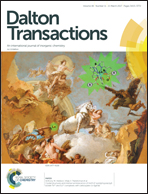Formation of hybrid ABX3 perovskite compounds for solar cell application: first-principles calculations of effective ionic radii and determination of tolerance factors†
Abstract
The development of hybrid organic–inorganic perovskite solar cells is one of the most rapidly growing fields in the photovoltaic community and is on its way to challenge polycrystalline silicon and thin film technologies. High power conversion efficiencies can be achieved by simple processing with low cost. However, due to the limited long-term stability and environmental toxicity of lead in the prototypic CH3NH3PbI3, there is a need to find alternative ABX3 constitutional combinations in order to promote commercialization. The Goldschmidt tolerance factor and the octahedral factor were found to be necessary geometrical concepts to evaluate which perovskite compounds can be formed. It was figured out that the main challenge lies in estimating an effective ionic radius for the molecular cation. We calculated tolerance factors and octahedral factors for 486 ABX3 monoammonium–metal–halide combinations, where the steric size of the molecular cation in the A-position was estimated concerning the total charge density. A thorough inquiry about existing mixed organic–inorganic perovskites was undertaken. Our results are in excellent agreement with the reported hybrid compounds and indicate the potential existence of 106 ABX3 combinations hitherto not discussed in the literature, giving hints for more intense research on prospective individual candidates.



 Please wait while we load your content...
Please wait while we load your content...